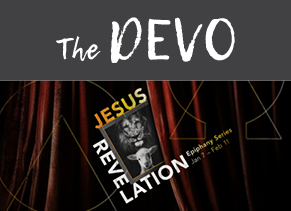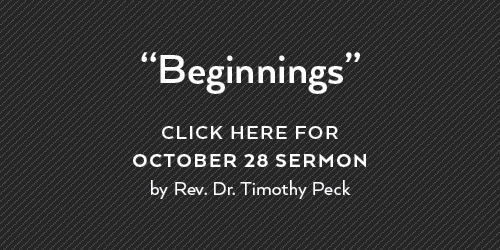Click for PDF version
Monday
Read Revelation 21:1-5
Life After Life After Death
Our sermon passage this week (Revelation 21:22-27) is found in the wider context of the vision of “a new heaven and a new earth” (v. 1). This image reminds us of God’s promises in the Old Testament to make all things new (Isaiah 65:17, 66:22), and symbolizes the restoration and renewal of creation. It reminds us that sin and brokenness will one day be eradicated, and that God’s original intention for creation will one day be fully realized.
Many Christians articulate their future hope as departing from this world and entering heaven. While it is true that God’s people will go to heaven and be with God after death (John 13:36-14:6; Philippians 3:20-21; 1 Thessalonians 4:13-14), theologians like N.T. Wright claim that Revelation 21 reveals a deeper truth about where our ultimate home will be after this life and after heaven. In this passage we read of a new heaven and a new earth, redeemed and renewed by God. And in this image believers don’t escape to heaven, but rather heaven comes down to earth. As Christians, heaven is an important promise, but our hope doesn’t end in heaven. Our hope is that God’s Kingdom will come and God’s will will be done on earth, that one day all things will be redeemed, and that God will once again live among God’s people.
In the words of N.T. Wright, “Our ultimate destiny is not a disembodied heaven, just as the ultimate destiny of this created world is not to be thrown away, abandoned as secondary or shabby,” for, “Easter speaks of a world reborn” (following Jesus). He calls this “life after life after death” (N.T. Wright). Whether taken literally or figuratively, Revelation 21 paints a picture of the hope that we have as the people of God: that God will make good on God’s promises, that all of creation will be made new, and that the redemptive work of Christ brings about the triumph of life over death.
Questions
How does the concept of “the new heaven and new earth” resonate with your personal beliefs and hopes for the future? Reflecting on the victory over sin and death portrayed in Revelation 21, how does the hope of eternal life influence your perspective on challenges and hardships in the present?
Prayer
For Stephen and Kate Clark, Campus 2 Campus Missionaries
Pray for their son, Ridley, who is in a Neonatal Intensive Care Unit (NICU). Pray for his lungs to completely heal so that he can start breathing room air and no longer need oxygen support.
Tuesday
Read John 2:13-22; Revelation 21:22
Jesus as the Temple
The image of Jesus as “the Lamb” (Rev. 21:22) is perhaps the most prominent image of Jesus in the Book of Revelation. As Pastor Tim taught us, Jesus is described as a lamb bearing the wounds of having been slaughtered for sacrifice. And in the Gospels that is indeed what happened: Jesus, the Lamb of God, was sacrificed for the sins of the world.
But here in Revelation 21, Jesus as the lamb is also described as “the Temple” (v. 22). Throughout Jewish history, the Temple was where God’s presence dwelled with God’s people. The Temple was the center of Jewish religious life and it served many purposes. It is where babies were dedicated, where people came to worship and pray, where the priests did their work, and where the Torah was read and taught. But perhaps most importantly, “various kinds of sacrifices were performed at the temple to remove impurities, atone for sins, and make peace with God.” (Lexham Bible Dictionary)
So, what does it mean for Jesus to be the Temple? Jesus is the Lamb of God who takes away the sins of the world (John 1:29), who was slaughtered to atone for our sins (Romans 5). In other words, Jesus is the Temple because Jesus fulfills the most important functions of the Temple.
“Jesus functioned as the temple because in Him atonement was made and the divine presence was revealed.” (Craig R. Koester) After all, why would we need to sacrifice at the Temple when we have already been made right with God? Why would we need to come to the Temple to hear God’s words read aloud when we live in the presence of Jesus, the Living Word (John 1:1)? What possible purpose would a Temple, the house of God, serve for those who have unencumbered, unfettered access to God?
In the Gospel of John, Jesus described Himself as the Temple: “Destroy this temple, and I will raise it again in three days” (John 2:19) And just as He said, He was crucified and rose from the dead three days later. In this vision, there is no Temple for Jesus is the Temple. Thanks be to God!
Questions
How does the imagery of Jesus as God’s Temple reshape your understanding of sacred spaces and the significance of the Temple in the Old Testament? How does Jesus being the Temple for believers affect the way you think of your own spiritual journey and connection with God?
Prayer
For Stephen and Kate Clark, Campus 2 Campus Missionaries
Pray for Ridley to learn to feed quickly. Specifically, he can’t graduate from the NICU until he completely finishes 8 bottles in a 24-hour period. Pray that this process goes quickly for him so that Stephen and Kate can bring him home soon.
Wednesday
Read Revelation 21:22; John 14:6-11; Philippians 2:5-7
The Divinity of Jesus
Revelation 21 alludes to several passages from the Old Testament (Isaiah 54:11-12, 60; 65:17; Ezekiel 40:2-5, 47:1-12; Zechariah 14:6-11). From God’s light covering all the earth, to the river of God flowing into the world, to a New Jerusalem, to the kings of this world paying honor to God—John’s vision is in line with those of Old Testament prophets. In many ways this is what the Jewish people would have expected, with one difference: Jesus plays the central role.
Today some might wonder if naming both “God Almighty” and “the Lamb” (v. 22) signifies that Jesus and YHWH are not one and the same. Afterall, why would they be differentiated here if they were not different? But for a 1st Century Jewish audience, seeing Jesus as the means by which God’s plan of redemption was brought about and seeing Jesus sharing roles with YHWH would relay a message of unity, not separation.
Jesus’ presence in Revelation paints a picture of oneness between Jesus and the God of Israel. In fact, if Revelation didn’t explicitly name Jesus, then many would have wondered if Jesus was the Messiah after all. Jesus being present and central to the entire book of Revelation makes it clear: Jesus is God’s promised deliverer and Jesus is one with God.
“God Almighty” and “the Lamb” together being the Temple is a great example of this. Jesus isn’t absent, nor does He replace YHWH—instead they are One. This is an image of unity, of Jesus doing what only God can do for God’s people: atoning for and forgiving their sins. This is what ultimately put Jesus at odds with religious leaders of His day. Jesus did what only God could do: He forgave people’s sins (Matthew 9:1-8).
Revelation 21 presents a vision of the redemption of all of creation. It’s a vision that would have seemed familiar in many ways to a 1st Century Jewish audience. And just in case there was any question as to Jesus’ divinity, there is no Temple—for God Almighty and Jesus are the Temple. Together, one God, forgiving our sins. Thanks be to God!
Questions
How does the revelation that “God Almighty” and “the Lamb” (Jesus) are the Temple deepen your understanding of the oneness within the Godhead? How does this idea resonate with your personal relationship with God? How might it influence your prayer life?
Prayer
For Stephen and Kate Clark, Campus 2 Campus Missionaries
Pray for mom and dad to get lots of rest. Balancing life at the NICU, work and home is no easy task.
Thursday
Read Revelation 21:23-25; Isaiah 60:19-20; John 1:9-14
The Light of the World
Despite the best efforts of the sun and the moon, the world we live in is full of darkness. Everywhere we look we see violence, abuse, illness, famine, poverty, brokenness. South African theologian and Anglican Bishop Desmund Tutu famously said, “Hope is being able to see that there is light despite all of the darkness.” (United Nations General Assembly) As Christians we are bearers of God’s hope for the world. But what exactly are we hoping for? Revelation 21 gives us our answer.
The answer: “a new heaven and a new earth,” married together through the life and love of Jesus our Lamb. And in this renewed creation, we see that there are many things that will have no place. Just as there is no Temple, for God almighty and the Lamb are its Temple, John also declares that there will be no sun or moon, “for the glory of God is its light and the Lamb is its lamp” (Revelation 21:23). No sun, yet the earth is filled with light. No night, no shame, no deceit. No sin, no pain, no death. Nothing to separate us from God or from one another. (Craig Keener) “Where, oh death, is your victory? Where, oh death, is your sting?” (1 Corinthians 15:55-57). What hope we have indeed!
The Gospel of John begins with the claim that Jesus, “the true light,” was coming into the world. “The light shines in the darkness, and the darkness has not overcome it” (John 1:5). And in 1 John we are told that, “God is light; in Him there is no darkness at all” (1 John 1:5). Surely we see glimpses of this light from time to time: in the Scriptures, in a friendship, in the face of a newborn baby; when someone forgives us, when someone loves us.
Like rays of light shining through the blinds of our window, God’s light shines through the darkness of our world. But one day that darkness will cease and only light will remain. God’s light will cover the earth, and everyone will know God. Revelation 21 articulates our hope: that one day the light of Jesus will cover the earth and darkness will be no more.
Questions
How does Jesus being the Source of light in the new creation influence your perception of His role in guiding and illuminating your spiritual journey? As a bearer of this hope, how might you actively participate in bringing God’s light to the world around you?
Prayer
For Stephen and Kate Clark, Campus 2 Campus Missionaries
A prayer of thankfulness for the Clarks support system—they’ve been provided so many meals and help with tasks at home that they aren’t able to do right now.
Friday
Read Genesis 1; Revelation 22:1-5
Creation and Re-Creation
In the first two chapters of Genesis, the first book of the Bible, we encounter a symphony of creation as God speaks the heavens, the earth, and every animal, bird, and sea creature into existence (1:1-25). The crowning achievement of creation is humanity, fashioned in the very image of God (1:26-27), living together with God in the garden (Genesis 2:15). And all of God’s creation was declared to be “very good” (1:31).
This good creation, however, is marred with the entrance of sin in Genesis 3. Harmony between humans and God, as well as one another, is disrupted and the consequences ripple through Scripture. Yet, even in the midst of brokenness, God hints at a redemptive plan, promising that the offspring of the woman will crush evil underfoot (Genesis 3:15).
In the last two chapters of Revelation, the last book of the Bible, we encounter a vision of new creation. The story harkens back to Genesis as God proclaims, “Behold, I am making all things new” (Revelation 21:5). After a long description of the Holy City, we see the picture of a garden where the curse of death has been broken (Revelation 22:1-5). The final chapters of the Bible echo the first chapters: creation, a garden, the tree of life, God with God’s people (George Eldon Ladd). In the beginning God created a world that was good and, at the end, God will renew and restore that which was lost. Creation and Re-creation.
The overlap between Genesis and Revelation tells a story of creation, fall, redemption, and ultimate restoration. God’s work in the world from Eden to the New Jerusalem tells of God’s unchanging character, unending love, and relentless pursuit of relationship with humanity.
We live in the time in between Genesis and Revelation, creation and re-creation. We feel the weight of sin in this world, even as we look ahead to the culmination of God’s redemptive plan. May we find hope in the promise of re-creation, where God’s “very good” design will be fully realized, and we will dwell once again with our Creator.
Questions
In what ways do you experience the effects of redemption in your life now, and what do you most look forward to in the fullness of God’s restoration? Contemplate the joy of God’s presence among us in the new creation. How does the promise of God dwelling with us without barriers impact your daily pursuit of intimacy with God?
Prayer
For Stephen and Kate Clark, Campus 2 Campus Missionaries
Pray that once Stephen and Kate get home, they are able to enjoy their time and transition well to their new rhythms.
Sources
- N.T. Wright, Following Jesus: Biblical Reflections on Discipleship (Grand Rapids: Wm. B. Eerdmans Publishing Company, 1995).
- N.T. Wright, Interview with Christian History Institute, originally published in 2014, accessed at https://christianhistoryinstitute.org/magazine/article/life-after-life-after-death
- Craig R. Koester, Revelation: A New Translation with Introduction and Commentary (The Anchor Yale Bible), John J. Collins, ed. (New Haven and London: Yale University Press, 2014).
- “Temple, Jerusalem” definition in The Lexham Bible Dictionary, John D. Barry, ed. (Bellingham, WA: Lexham Press, 2016).
- United Nations General Assembly, “Memorial Service for Archbishop Desmund Tutu” accessed at https://www.un.org/pga/76/2022/02/13/memorial-service-for-archbishop-desmond-tutu/.
- Craig S. Keener, The IVP Bible Background Commentary, New Testament (Downers Grove: InterVarsity Press, 1993), 818-19.
- George Eldon Ladd, A Commentary on the Revelation of John (Grand Rapids: Wm. B. Eerdmans Publishing Company, 1972), 286-287.



Leave a Reply